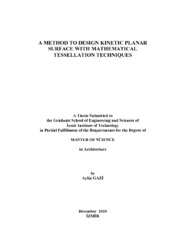Please use this identifier to cite or link to this item:
https://hdl.handle.net/11147/3510Full metadata record
| DC Field | Value | Language |
|---|---|---|
| dc.contributor.advisor | Korkmaz, Koray | en |
| dc.contributor.author | Gazi Gezgin, Aylin | - |
| dc.date.accessioned | 2014-07-22T13:51:42Z | - |
| dc.date.available | 2014-07-22T13:51:42Z | - |
| dc.date.issued | 2010 | en |
| dc.identifier.uri | http://hdl.handle.net/11147/3510 | - |
| dc.description | Thesis (Master)--İzmir Institute of Technology, Architecture, İzmir, 2010 | en |
| dc.description | Includes bibliographical references (leaves: 113-120) | en |
| dc.description | Text in English; Abstract: Turkish and English | en |
| dc.description | xv, 122 leaves | en |
| dc.description.abstract | Due to rapid change in activities on modern society in XXth century, need of adaptation has emerged, which was the necessary precondition for the rise of the concept of motion or kinetic in architecture. Kinetic architecture is a controversial interdisciplinary area between architecture and mechanisms science. Many kinetic designers and researchers usually reach transformable, deployable or foldable structures by using mechanical knowledge. However, there are not many researches that focus on the surfaces between kinetic structures. Those surfaces generally covered with flexible or flat materials. Kinetic architects, who usually deal with a particular type of the mechanism, can easily control the design of mechanism. Therefore, a method is necessary to construct a network with planar mechanisms for variable building surfaces due to the fact that it can be a problem of studying during the design process of kinetic building parts. Many questions might be a problem such as how many links should be used, what kind of joints and platform should be chosen and finally the mobility of the whole kinetic system. To design a surface has been one of the major problems for architects. Through the history, architecture has benefited from mathematics such as golden ratio, fractal geometry and tessellation. Tessellation is a kind of mathematical technique that was usually used to cover a plane without any gaps or overlaps, because of this properties, it uses to design surfaces. So, the main purpose of this study is to develop a methodology to design kinetic planar surfaces with mathematical regular tessellation technique in the light of architectural, mechanical and mathematical interdisciplinary approach. | en |
| dc.language.iso | en | en_US |
| dc.publisher | Izmir Institute of Technology | en_US |
| dc.rights | info:eu-repo/semantics/openAccess | en_US |
| dc.subject.lcc | NA2750 .G28 2010 | en |
| dc.subject.lcsh | Architecture--Mathematics | en |
| dc.subject.lcsh | Architectural desing--Mathematics | en |
| dc.subject.lcsh | Tessellations (Mathematics) | en |
| dc.title | A method to design kinetic planar surface with mathematical tessellation techniques | en_US |
| dc.type | Master Thesis | en_US |
| dc.institutionauthor | Gazi Gezgin, Aylin | - |
| dc.department | Thesis (Master)--İzmir Institute of Technology, Architecture | en_US |
| dc.relation.publicationcategory | Tez | en_US |
| item.languageiso639-1 | en | - |
| item.fulltext | With Fulltext | - |
| item.openairecristype | http://purl.org/coar/resource_type/c_18cf | - |
| item.openairetype | Master Thesis | - |
| item.grantfulltext | open | - |
| item.cerifentitytype | Publications | - |
| Appears in Collections: | Master Degree / Yüksek Lisans Tezleri | |
Files in This Item:
| File | Description | Size | Format | |
|---|---|---|---|---|
| T000861.pdf | MasterThesis | 20.06 MB | Adobe PDF |  View/Open |
CORE Recommender
Page view(s)
380
checked on Jul 22, 2024
Download(s)
202
checked on Jul 22, 2024
Google ScholarTM
Check
Items in GCRIS Repository are protected by copyright, with all rights reserved, unless otherwise indicated.